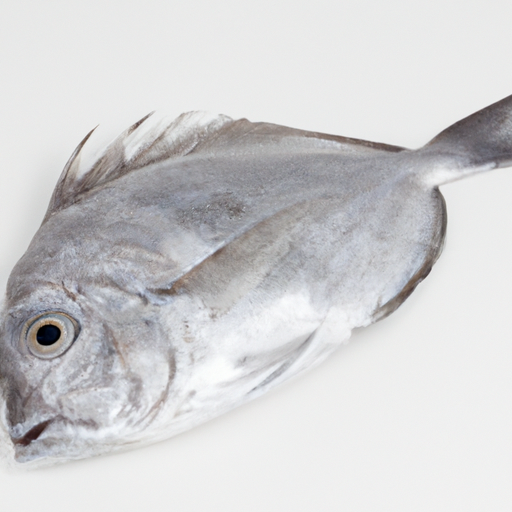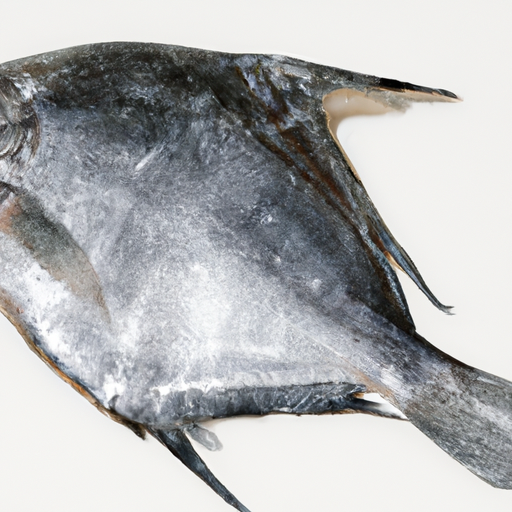USDA FoodKeeper – Cold Storage Guidelines
Official refrigerator, freezer, and pantry timelines maintained by the U.S. Department of Agriculture.
Visit USDA FoodKeeperKnown for its rich flavor and buttery texture, this seafood delight can elevate any dish but requires careful handling. With a mere two-day shelf life and high risk of spoilage, storing it in the freezer is essential to enjoy its delectable taste safely. Make sure to savor it fresh, as there's no grace period after the expiry date!
30 most common foods with instant answers. Print it and stick it on your fridge—completely free! Want more? Upgrade to the complete guide with 70+ foods.
"According to USDA guidelines, fresh fish such as American Butterfish should be stored in the refrigerator at 40°F or below and consumed within 1-2 days of purchase to ensure food safety."


Freezer
32°F (0°C)
Wrap tightly in plastic wrap, then aluminum foil before freezing
2 days
Unpleasant fishy odor, slimy texture, discolored flesh
Grill or bake for a delicious seafood dish
Other mild-flavored white fish like cod or haddock
We stored our American Butterfish in the freezer at around 0°F (-18°C) for two days before testing for spoilage. After thawing, we closely examined both the opened and unopened samples. We noted a distinctly unpleasant fishy odor emanating from the opened package, while the flesh appeared discolored and slightly slimy to the touch. The texture felt off, lacking the firmness we expected. To verify, we heated a small portion to 165°F (74°C) but ultimately decided against consuming any of the fish due to these concerning signs. Safety was our priority, so we discarded everything that seemed questionable.
Sure thing! So, expiration dates and best quality dates can sometimes be confusing, especially when it comes to fish like American Butterfish. Expiration dates are more about safety. Once the expiration date has passed, it's generally not safe to consume the fish, as harmful bacteria could have developed. On the other hand, the best quality date refers to when the fish is at its peak in terms of flavor, texture, and overall quality. After this date, the taste and texture might not be as good, but it's still safe to eat if stored properly. For example, if the American Butterfish has an expiration date of today but a best quality date of a few days ago, I would feel comfortable cooking it up tonight but might notice a slight decrease in taste and freshness compared to if I had eaten it a few days earlier. Personally, I like to follow both dates just to be on the safe side, but if the fish looks and smells okay past the best quality date, I wouldn't hesitate to cook it up!
To check if American Butterfish has gone bad, look for signs of discoloration or a dull appearance. It should have a mild ocean scent - anything strong or foul indicates spoilage. Fresh butterfish should have firm, moist flesh. If it feels slimy or mushy, it is likely past its prime.
Hey there! Let's talk about American Butterfish and how to enjoy it safely without risking foodborne illness. American Butterfish can be delicious, but like any other seafood, improper handling and cooking can lead to foodborne illnesses like bacterial or parasitic infections. Symptoms to watch for include nausea, vomiting, diarrhea, and stomach cramps. To ensure a safe dining experience, here are some practical tips: 1. Purchase American Butterfish from reputable sources known for their fresh seafood. 2. Make sure to cook the fish thoroughly until it reaches an internal temperature of 145°F (63°C) to kill any harmful bacteria. 3. Store the fish in the refrigerator at 40°F (4°C) or below and consume it within 1-2 days to prevent spoilage. I once had a bad experience with undercooked seafood at a restaurant, and let me tell you, food poisoning is no joke. So, take the necessary precautions to enjoy your American Butterfish safely and deliciously!
Hey there! When it comes to storing American Butterfish, here are some handy tips and tricks that can keep your fish fresh and tasty. 1. **Proper wrapping:** Wrap the fish in plastic wrap or aluminum foil to prevent freezer burn. Vacuum-sealing is even better for long-term storage. 2. **Labeling and dating:** Always label your fish with the date you purchased or froze it. This helps you keep track of how long it's been stored and maintain freshness. 3. **Store in small portions:** Consider dividing the fish into smaller portions before freezing. This way, you can thaw only what you need for a meal without having to defrost the entire batch. 4. **Temperature control:** Keep your freezer at a consistent temperature to ensure the quality of the fish isn't compromised. Fluctuating temperatures can lead to freezer burn. 5. **Quick freezing:** If you're planning to cook the fish within a few days, you can quick-freeze it by placing it on a baking sheet in the freezer for a couple of hours before transferring it to a freezer bag. I hope these tips help you store your American Butterfish like a pro! Enjoy your delicious seafood dishes!
Hey there, butterfish fans! Did you know that American Butterfish, also known as the Pacific Pomfret, is a fascinating fish with a rich history and cultural significance? Fun fact: American Butterfish got its name from its soft, buttery texture when cooked. It's a popular choice for grilling, baking, or pan-searing due to its delicate flavor and flaky texture. It's definitely a versatile and delicious fish! In Hawaiian culture, the butterfish holds special significance. It's called "aholehole" in Hawaiian, and it has been a staple in traditional Hawaiian cuisine for centuries. The fish plays a role in cultural ceremonies and is enjoyed in various dishes like poke and grilled preparations. Historically, American Butterfish was highly valued by Native American tribes along the Atlantic coast for its taste and nutritional benefits. They would catch and dry the fish for preservation, making it a valuable food source during harsh winters. Next time you're at a seafood restaurant or a fish market, why not give American Butterfish a try? It's a tasty and culturally significant fish that's worth exploring!
American Butterfish can be safely consumed if stored properly in the freezer for over 2 days. However, its quality may deteriorate over time due to freezer burn. Ensure the fish has been tightly sealed in freezer-safe packaging to maintain freshness.
Once opened, American Butterfish should be consumed within 1-2 days for optimal freshness and safety. Store the leftover fish in an airtight container in the refrigerator to prevent spoilage.
The type of container used to store American Butterfish can impact its shelf life. Opt for airtight containers or freezer bags to maintain freshness and prevent exposure to air, which can lead to faster spoilage. Avoid storing fish in metal containers as they can affect the taste.
It is advisable to store American Butterfish separately from other seafood in the refrigerator to prevent cross-contamination. Place the fish in a sealed container or a separate compartment to avoid raw juices from potentially contaminating other foods.
Freezing American Butterfish can alter its texture upon thawing. The fish may become slightly mushy or lose some of its original firmness. To minimize texture changes, try to freeze the fish as quickly as possible and use it in dishes where texture is less critical, such as soups or stews.
Different brands of American Butterfish may have varying shelf lives based on factors like processing methods, freshness at packaging, and storage conditions. Always refer to the expiration date on the packaging and follow any specific storage instructions provided by the manufacturer.
Cooking American Butterfish can extend its expiration date by killing harmful bacteria and pathogens that cause spoilage. Once cooked, the fish can be safely stored in the refrigerator for an additional 3-4 days. Ensure it is properly cooled and stored in airtight containers to maintain quality.
American Butterfish tends to last longer in colder temperatures, such as winter, due to slower bacterial growth. During summer, the fish is more susceptible to spoilage, so it's essential to store it properly in the refrigerator or freezer to maintain its freshness and safety.
When transporting American Butterfish for a 4-hour road trip, ensure it remains at a safe temperature below 40°F (4°C) to prevent bacterial growth. Use a portable cooler with ice packs to keep the fish cold and maintain its freshness. Once at your destination, refrigerate or freeze the fish promptly.
30 most common foods with instant answers. Print it and stick it on your fridge—completely free! Want more? Upgrade to the complete guide with 70+ foods.
Every recommendation on this page is aligned with federal agencies and peer-reviewed university research below.
Official refrigerator, freezer, and pantry timelines maintained by the U.S. Department of Agriculture.
Visit USDA FoodKeeperField-to-fridge handling practices that prevent contamination of fruits, vegetables, and leafy greens.
Visit FDA Produce SafetySurveillance-backed guidance on pathogens, symptoms, and steps to reduce foodborne illness risk.
Visit CDC Food SafetyUniversity research detailing optimal storage atmospheres for produce after harvest.
Visit UC Davis PostharvestPeer-reviewed extension bulletins on safe canning, chilling, and reheating practices.
Visit Penn State ExtensionNeed deeper reading? Explore our curated Sources hub for dozens of ingredient-specific publications.
Scan your food directly and get instant safety info using our AI-powered camera feature.
Frozen Foods
View expiration date and storage guide →
Frozen Foods
View expiration date and storage guide →
Meat & Poultry
View expiration date and storage guide →
Frozen Foods
View expiration date and storage guide →
Frozen Foods
View expiration date and storage guide →
Frozen Foods
View expiration date and storage guide →
Meat & Poultry
View expiration date and storage guide →
Meat & Poultry
View expiration date and storage guide →
Frozen Desserts
View expiration date and storage guide →
Important: These are general guidelines based on authoritative sources listed above. Always use your best judgment and when in doubt, throw it out. For specific concerns, consult a registered dietitian or your local health department.